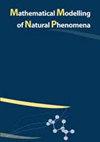耦合神经元细胞内钙浓度的多时间尺度网络模型:来自模拟的见解。
IF 2.1
4区 数学
Q2 MATHEMATICAL & COMPUTATIONAL BIOLOGY
引用次数: 3
摘要
在[16]中,作者分析了两个对称耦合的相同3D慢速快速振荡器之间的同步特征,这两个振荡器是FitzHugh–Nagumo动力学生成混合模式振荡的扩展。第三个变量是缓慢的,代表神经元中的细胞内钙浓度。在这里,我们考虑这个模型在两个方向上的扩展。首先,我们考虑了单元之间的异质性,并分析了两个具有不同值的振荡器对一个参数调谐固有频率的耦合。我们发现了反相位同步的新模式,具有非平凡的特征,并且在过渡中表现出魔鬼阶梯现象。其次,我们引入了一个由N细胞组成的网络,该网络分为两个簇:每个簇中神经元之间的耦合是兴奋性的,而两个簇之间的耦合则是抑制性的。这样的系统模拟了两个相互抑制的亚群中倾向于同步的神经元之间的相互作用,如同侧和对侧运动神经元组合。为了在N较大时进行数值模拟,作为网络分析的第一步,我们考虑了降阶模型以节省计算成本。我们在一个由100个单元组成的网络中给出了数值简化的结果。为了验证数值归约方法,我们比较了不同情况下获得的输出和CPU时间。本文章由计算机程序翻译,如有差异,请以英文原文为准。
A MULTIPLE TIMESCALE NETWORK MODEL OF INTRACELLULAR
CALCIUM CONCENTRATIONS IN COUPLED NEURONS: INSIGHTS FROM
ROM SIMULATIONS.
In [16], the authors analyzed the synchronization features between two identical 3D slow-fast oscillators, symmetrically coupled, built as an extension of the FitzHugh–Nagumo dynamics generating Mixed-Mode Oscillations. The third variable, which is slow, represents the intracellular calcium concentration in neurons. Here, we consider an extension of this model in two directions. First, we consider heterogeneity among cells and analyze the coupling of two oscillators with different values for one parameter tuning the intrinsic frequency. We identify new patterns of antiphasic synchronization, with non-trivial signatures and that exhibit a Devil’s Staircase phenomenon in transitions. Second, we introduce a network of N cells divided into two clusters: the coupling between neurons in each cluster is excitatory, while between the two clusters is inhibitory. Such system models the interactions between neurons tending to synchronization in two subpopulations inhibiting each other, like ipsi- and contra-lateral motoneurons assemblies. To perform the numerical simulations when N is large, as an initial step towards the network analysis, we consider Reduced Order Models to save computational costs. We present the numerical reduction results in a network of 100 cells. To validate the numerical reduction method, we compare the outputs and CPU times obtained in different cases.
求助全文
通过发布文献求助,成功后即可免费获取论文全文。
去求助
来源期刊

Mathematical Modelling of Natural Phenomena
MATHEMATICAL & COMPUTATIONAL BIOLOGY-MATHEMATICS, INTERDISCIPLINARY APPLICATIONS
CiteScore
5.20
自引率
0.00%
发文量
46
审稿时长
6-12 weeks
期刊介绍:
The Mathematical Modelling of Natural Phenomena (MMNP) is an international research journal, which publishes top-level original and review papers, short communications and proceedings on mathematical modelling in biology, medicine, chemistry, physics, and other areas. The scope of the journal is devoted to mathematical modelling with sufficiently advanced model, and the works studying mainly the existence and stability of stationary points of ODE systems are not considered. The scope of the journal also includes applied mathematics and mathematical analysis in the context of its applications to the real world problems. The journal is essentially functioning on the basis of topical issues representing active areas of research. Each topical issue has its own editorial board. The authors are invited to submit papers to the announced issues or to suggest new issues.
Journal publishes research articles and reviews within the whole field of mathematical modelling, and it will continue to provide information on the latest trends and developments in this ever-expanding subject.
 求助内容:
求助内容: 应助结果提醒方式:
应助结果提醒方式:


